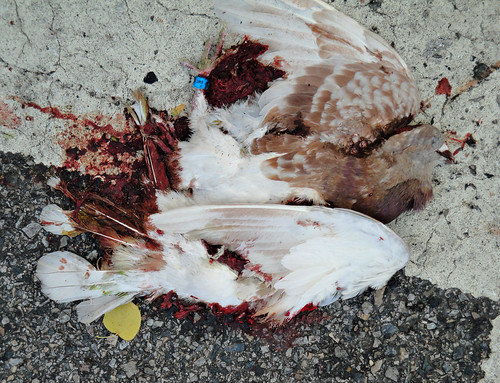
It appears that this pigeon took a blow from the rear from an auto while trying to alight from the pavement. (Image made by me in Baltimore in 2010).
I thought that the following article made for interesting reading, in light of the fate that befell the bird in the above image. The article could lead one to speculate on how the pressures of natural selection are changing birds like pigeons and sparrows in an urban environment.
Evolution via Roadkill (March 18 2013):
Cliff swallows that build nests that dangle precariously from highway overpasses have a lower chance of becoming roadkill than in years past thanks to a shorter wingspan that lets them dodge oncoming traffic. That’s the conclusion of a new study based on 3 decades of data collected on one population of the birds. The results suggest that shorter wingspan has been selected for over this time period because of the evolutionary pressure put on the population by cars.
“This is a clear example of how you can observe natural selection over short time periods,” says ecologist Charles Brown of the University of Tulsa in Oklahoma, who conducted the new study with wife Mary Bomberger Brown, an ornithologist at the University of Nebraska, Lincoln. “Over 30 years, you can see these birds being selected for their ability to avoid cars.”
The Browns have studied cliff swallows (Petrochelidon pyrrhonota) in southwestern Nebraska since 1982. They return to the same roads every nesting season to perform detailed surveys of the colonies of thousands of birds that build mud nests on bridges and overpasses in the area. Along with studies on living swallows—counting birds and eggs, netting and banding individuals, and observing behaviors—the Browns also picked up swallow carcasses they found on the roads, in the hopes of having additional specimens to measure and preserve. They hadn’t planned studies on roadkill numbers, but recently they began to get the sense that they were picking up fewer dead birds than in the past.
When the researchers looked back at the numbers of swallows collected as roadkill each year, they found that the count had steadily declined from 20 birds a season in 1984 and 1985 to less than five per season for each of the past 5 years. During that same time, the number of nests and birds had more than doubled, and the amount of traffic in the area had remained steady.
The birds that were being killed, further analysis revealed, weren’t representative of the rest of the population. On average, they had longer wings. In 2012, for example, the average cliff swallow in the population had a 106-millimeter wingspan, whereas the average swallow killed on the road had a 112-millimeter wingspan.
